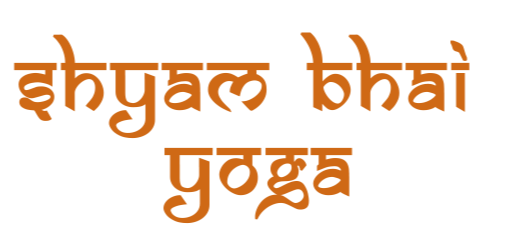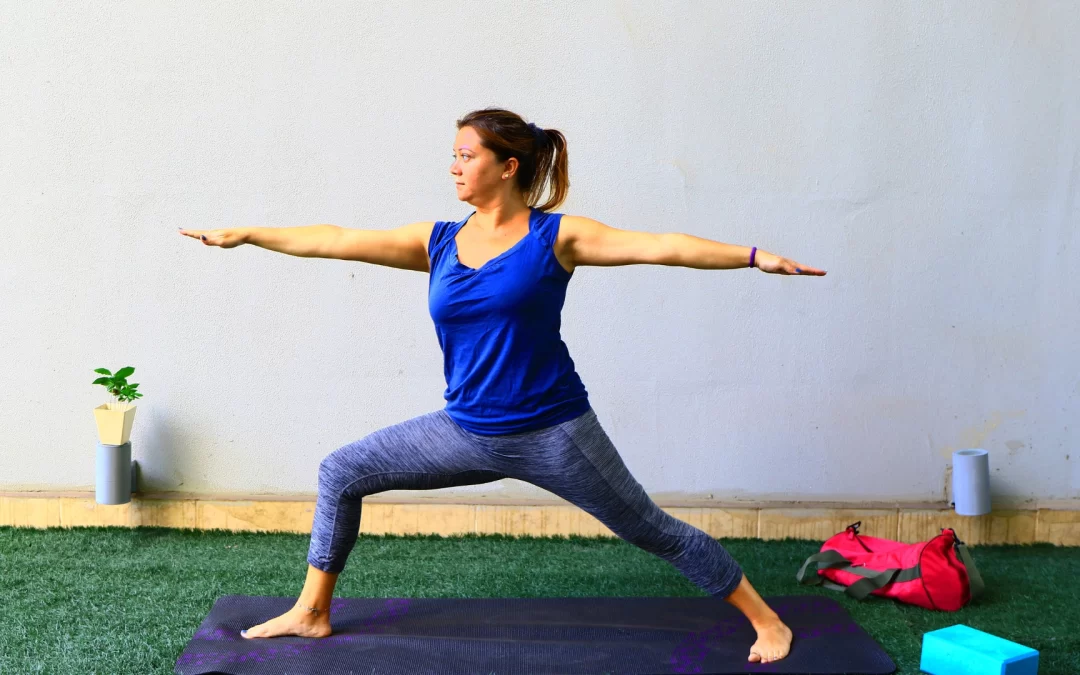Which Yoga Poses Help in Reducing Thigh and Hip Fat?
Body fat distribution patterns, particularly in the thigh and hip regions, often result from a complex interplay of genetics, hormones, lifestyle, and individual body composition. Southern states like Tamil Nadu report higher obesity rates among women. A study indicates a 9.5% increase in obesity levels among women in Tamil Nadu, highlighting regional disparities. While yoga cannot spot-reduce fat from specific areas (no exercise truly can), certain yoga poses and sequences can create comprehensive changes supporting healthier body composition through multiple physiological pathways. Understanding how yoga contributes to overall fat metabolism while strengthening and toning the lower body provides a realistic framework for addressing thigh and hip concerns through consistent practice.
Understanding Lower Body Fat Patterns
Before exploring specific yoga approaches, understanding the nature of thigh and hip fat provides important context:
Physiological Factors Influencing Thigh and Hip Fat
Several biological factors influence fat accumulation in the lower body:
- Estrogen Effects: This hormone promotes fat storage in the hips, thighs, and buttocks, particularly in women
- Alpha vs. Beta Receptors: Lower body fat typically contains more alpha-receptors that resist fat breakdown
- Blood Flow Variations: Circulation to lower body fat stores is often less efficient
- Muscle-to-Fat Ratio: Lower muscle density in the region provides less metabolic activity
- Genetic Predisposition: Inherited body composition tendencies significantly influence fat distribution
Why Comprehensive Approaches Work Best
Understanding these factors explains why effective strategies must address:
- Overall caloric balance and metabolism
- Hormonal equilibrium through stress reduction
- Improved circulation to lower body regions
- Increased muscle density in target areas
- Consistency rather than intensity of approach
How Yoga Influences Body Composition
Yoga contributes to healthy body composition through multiple mechanisms:
1. Metabolic Enhancement
Several aspects of yoga practice influence metabolic function:
- Muscle Activation: Many poses engage large muscle groups, increasing energy expenditure
- Post-Practice Metabolic Effect: Challenging sequences can elevate metabolism for hours afterward
- Muscular Development: Regular practice builds lean tissue that increases resting metabolic rate
- Improved Mitochondrial Function: Consistent practice enhances cellular energy production
- Hormonal Balance Support: Stress reduction helps normalize hormones affecting fat storage
Research in the Journal of Physical Activity and Health demonstrates that regular yoga practitioners show improved metabolic parameters compared to sedentary controls, including better glucose regulation and lipid profiles.
2. Hormonal Regulation
Yoga’s effects on the endocrine system influence fat metabolism:
- Cortisol Normalization: Reduces the stress hormone linked to abdominal and thigh fat storage
- Insulin Sensitivity: Improves the body’s response to insulin, enhancing proper energy utilization
- Thyroid Support: Certain poses and breathing practices may support healthy thyroid function
- Growth Hormone Production: Challenging poses may stimulate growth hormone that aids fat metabolism
- Catecholamine Response: Dynamic practice activates adrenaline and noradrenaline that facilitate fat breakdown
These hormonal effects create a more favorable internal environment for maintaining healthy body composition.
3. Improved Circulation and Fluid Dynamics
Many yoga poses specifically enhance blood and lymph flow to the lower body:
- Inversions: Reverse normal gravitational patterns affecting fluid movement
- Compression-Release Sequences: Create a pumping action enhancing circulatory efficiency
- Twisting Poses: Wring out venous blood and allow fresh arterial flow upon release
- Dynamic Transitions: Generate circulatory activation through movement patterns
- Breathing Coordination: Enhances the pressure differentials that drive lymphatic circulation
Enhanced circulation delivers more oxygen and nutrients to tissues while improving removal of metabolic waste products and excess fluid.
4. Targeted Muscle Activation and Toning
Specific yoga poses intensely engage the muscles underlying areas of concern:
- Lower Body Strengthening: Builds lean muscle tissue that increases metabolic demand
- Multi-Angle Engagement: Works muscles through various planes of movement
- Eccentric Muscle Loading: Creates microtrauma that stimulates muscle development
- Isometric Contractions: Sustained holds that build muscular endurance and tone
- Muscle Balance Improvement: Addresses compensatory patterns that affect appearance
Specialized Online Yoga Classes For Weight Loss provide structured sequences specifically addressing body composition concerns, with attention to proper alignment and appropriate progressions for targeting thigh and hip regions effectively.
While these effects won’t spot-reduce fat, they improve muscle tone beneath fat layers, creating a more defined appearance even before significant fat loss occurs.
Most Effective Yoga Poses for Thigh and Hip Concerns
The following poses and sequences specifically target lower body composition through multiple mechanisms:
1. Standing Poses for Lower Body Activation
These fundamental poses create significant engagement in thigh and hip regions:
a) Warrior II (Virabhadrasana II)
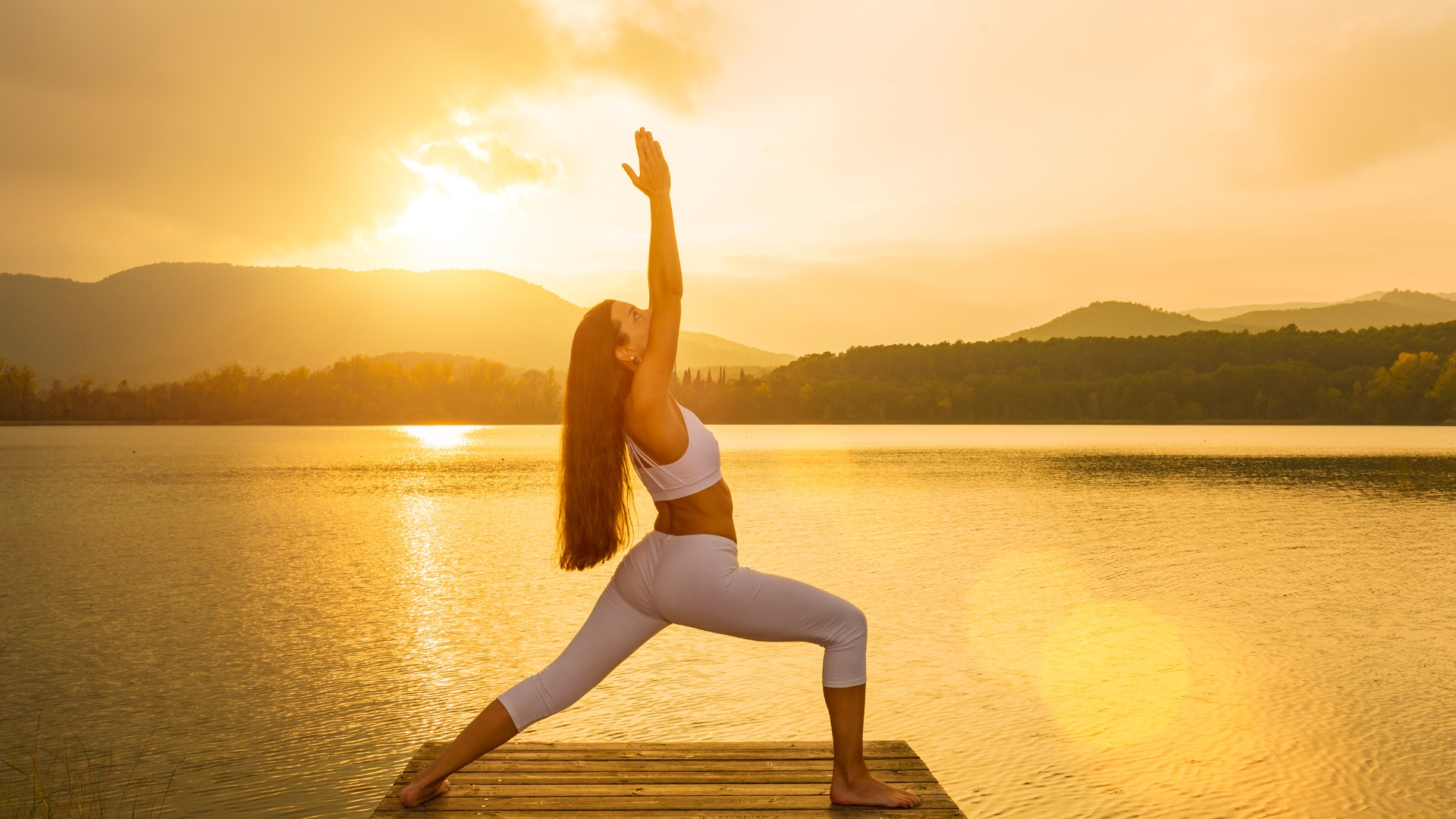
This foundational pose intensely engages multiple lower body muscles:
- Front leg quadriceps, hamstrings, and gluteal muscles work isometrically
- Inner and outer thigh muscles engage for stability
- Extended hold time creates endurance challenge and metabolic demand
- Regular practice builds significant lower body strength and tone
Practice Tip: Maintain a deep bend in the front knee while keeping it aligned with ankle, creating maximum muscular engagement.
b) Extended Side Angle Pose (Utthita Parsvakonasana)
This pose combines lateral stretching with intense lower body work:
- Deep engagement of quadriceps, hamstrings, and glutes
- Inner thigh strengthening and toning
- Side-body lengthening that improves overall appearance
- Twisting element that enhances circulation to core and lower body
Practice Tip: Keep the bent knee at 90 degrees with thigh parallel to floor for maximum thigh muscle activation.
c) Goddess Pose (Utkata Konasana)
This wide-stance squat specifically targets inner and outer thighs:
- Intense engagement of adductor (inner thigh) muscles
- Deep quadriceps and gluteal activation
- Challenges muscular endurance when held for time
- Creates significant metabolic demand during practice
Practice Tip: Try adding small pulses or holding for longer durations to increase the intensity and effectiveness.
2. Balancing Poses for Deep Muscular Engagement
These poses create intense stabilization demands on lower body muscles:
a) Extended Hand-to-Big-Toe Pose (Utthita Hasta Padangusthasana)
This challenging balance pose engages the standing leg intensely:
- Creates deep engagement through entire standing leg
- Requires significant core-lower body integration
- Improves both strength and stability in hip complex
- Enhances proprioception for improved movement patterns
Practice Tip: Use a wall or chair for support while building strength, focusing on activation rather than flexibility.
b) Eagle Pose (Garudasana)
This twisted standing balance works deeply into hips and thighs:
- Creates intense outer hip and thigh work
- Engages stabilizing muscles often overlooked
- Improves hip mobility while building strength
- Enhances circulation through compression-release effect
Practice Tip: Focus on squeezing thighs together and sitting deeper into the pose to maximize engagement.
c) Tree Pose (Vrksasana)
This fundamental balance pose creates subtle but effective hip stabilization:
- Activates standing leg completely from foot to hip
- Engages often-neglected hip stabilizers
- Builds muscular endurance through sustained hold
- Creates mind-muscle connection enhancing workout effectiveness
Practice Tip: Engage the standing leg fully by lifting the arch and activating the quadriceps completely.
3. Dynamic Sequences for Metabolic Enhancement
These flowing sequences increase caloric expenditure while targeting lower body:
a) Sun Salutations with Lunges (Surya Namaskar Variations)
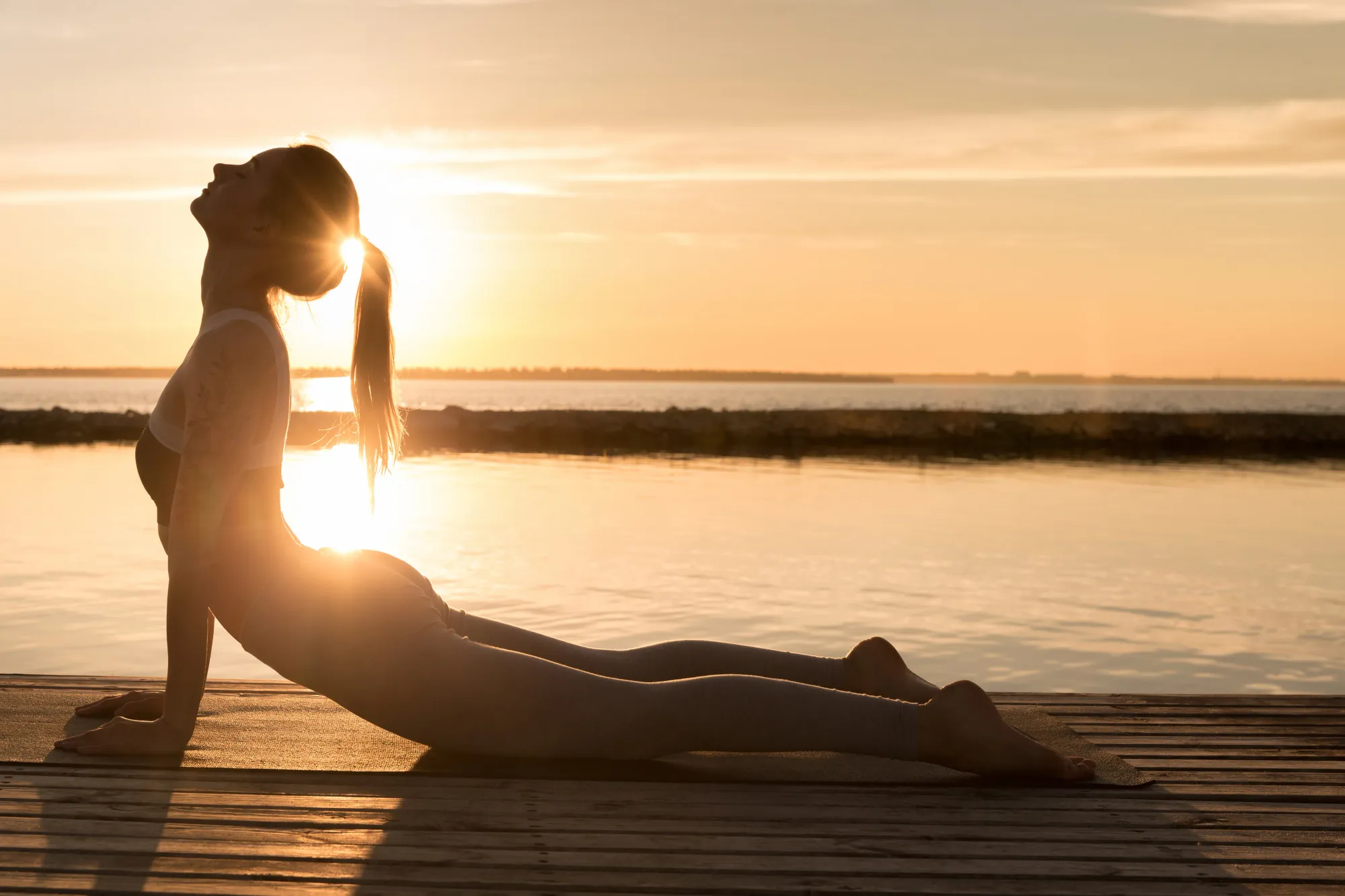
These traditional sequences can be modified to emphasize lower body work:
- Multiple transitions through lunges engage thighs and hips
- Continuous movement elevates heart rate and metabolic demand
- Builds both strength and endurance in lower body
- Creates post-exercise metabolic elevation
Practice Tip: Deepen lunges and extend hold times in lower body positions to intensify the effects.
b) Flow Between Warrior Poses
Transitioning between warrior poses creates intense lower body demands:
- Continuous engagement of quadriceps, hamstrings, and gluteals
- Dynamic movement improves circulation to lower body
- Creates both strength and endurance challenges
- Engages full range of motion in hip complex
Practice Tip: Move slowly between transitions to maintain muscular engagement rather than using momentum.
c) Chair Pose Sequences (Utkatasana Variations)
Variations and flows incorporating chair pose target the entire lower body:
- Deep engagement of quadriceps and gluteal muscles
- Sustained isometric holds build muscular endurance
- Pulsing variations increase intensity and metabolic demand
- Twisting elements engage obliques while maintaining leg work
Practice Tip: Keep weight in heels and sit deeper to maximize thigh engagement during all variations.
4. Hip-Opening Poses for Structural Balance
These poses address tight hip patterns that affect lower body appearance:
a) Pigeon Pose (Eka Pada Rajakapotasana)
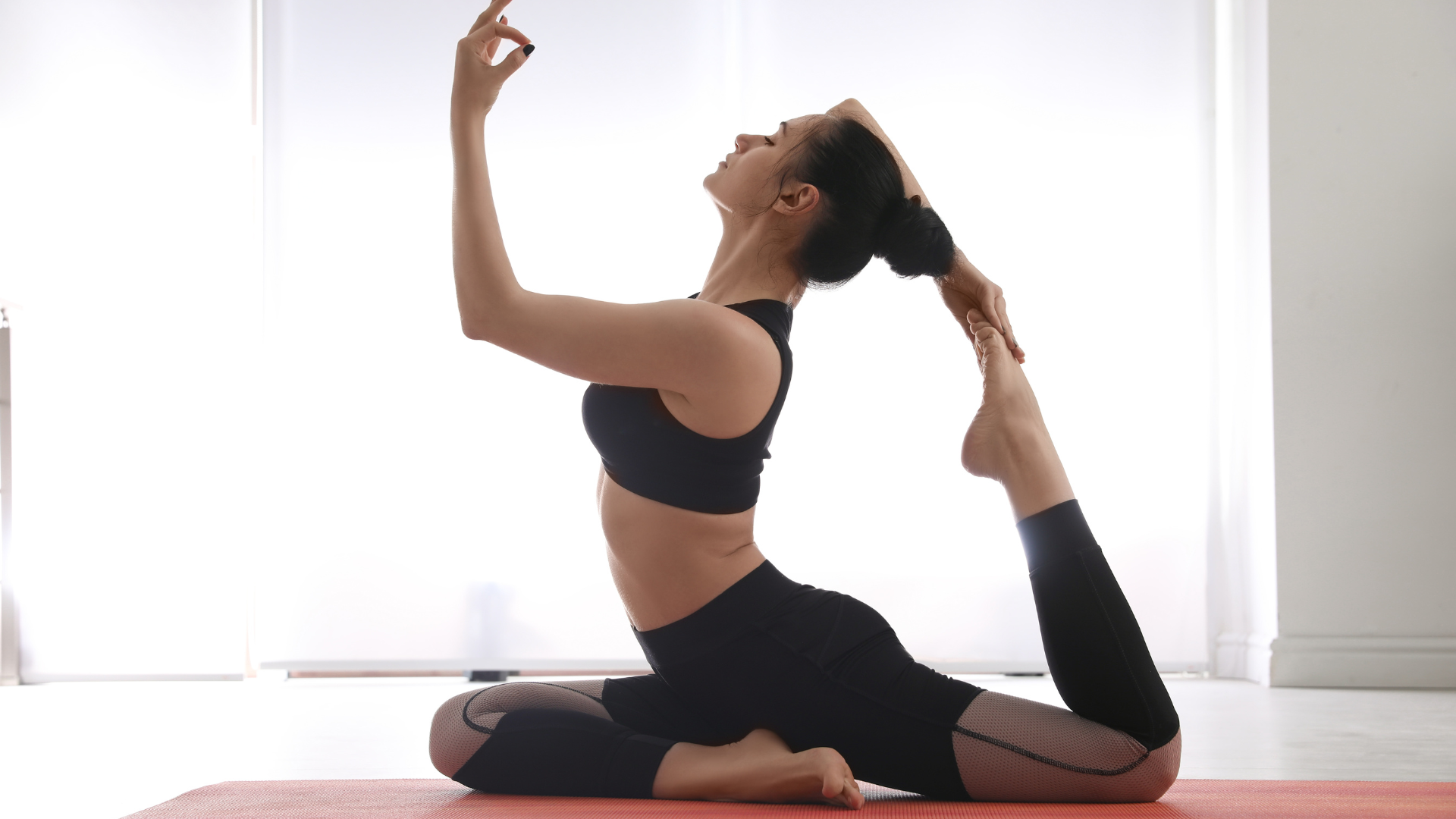
This deep hip opener affects overall lower body appearance:
- Releases hip rotators that contribute to lower body tension patterns
- Improves structural alignment affecting posture and appearance
- Enhances circulation to hip complex
- Creates space for more effective strengthening work
Practice Tip: Focus on relaxing into the pose rather than forcing depth, allowing for therapeutic release.
b) Frog Pose (Mandukasana)
This intense inner thigh and groin opener improves lower body mechanics:
- Creates significant opening through adductors and inner thighs
- Releases tension patterns affecting overall leg appearance
- Improves hip mobility for more effective strengthening work
- Enhances circulation throughout pelvic region
Practice Tip: Support with blankets under knees if needed, focusing on gradual release rather than maximum stretch.
Check out our blog, Why Is Consistency Important in Yoga for Weight Loss?
Creating an Effective Practice for Lower Body Transformation
For optimal results addressing thigh and hip concerns:
1. Balanced Approach Integration
Combine multiple elements for comprehensive effects:
- Include both strengthening and lengthening poses
- Integrate dynamic sequences for metabolic enhancement
- Add targeted toning poses for problem areas
- Include relaxation and recovery elements for hormonal balance
- Incorporate breathwork supporting overall metabolic health
2. Progressive Challenge Development
Build intensity strategically for sustainable progress:
- Begin with proper form and alignment fundamentals
- Gradually increase hold times in strengthening poses
- Progressively deepen ranges of motion as appropriate
- Add dynamic elements as strength and stability improve
- Incorporate more advanced variations as foundation strengthens
3. Consistency and Frequency Prioritization
Establish a sustainable practice rhythm:
- Aim for 3-5 sessions weekly focusing on lower body
- Include shorter daily practices for continuous stimulus
- Balance more intense sessions with recovery-focused practices
- Create realistic scheduling that supports long-term adherence
- Track progress to maintain motivation through normal plateaus
Expert Guidance for Optimal Results
While self-practice offers benefits, proper instruction ensures safe, effective technique for optimal results.
For those seeking comprehensive wellness supporting overall body composition goals, Online Yoga Classes offer diverse approaches that can be integrated into a balanced practice addressing multiple aspects of physical and mental wellbeing.
Beyond the Physical: Yoga’s Holistic Approach to Body Image
Yoga’s most profound contribution to body transformation often comes through its mental and emotional effects:
Cultivating Body Acceptance
Regular practice often shifts perspective beyond appearance:
- Developing appreciation for body functionality over aesthetics
- Building awareness of incremental progress and non-scale victories
- Creating more compassionate relationship with physical appearance
- Establishing deeper connection with body’s signals and needs
- Recognizing cultural conditioning around “ideal” body types
Reducing Stress-Related Patterns
Yoga’s stress-reduction benefits directly impact body composition:
- Lowering stress-related emotional eating triggers
- Reducing cortisol-driven fat storage patterns
- Improving sleep quality supporting healthy metabolism
- Enhancing recovery between physical activities
- Breaking cycles of stress and self-criticism affecting health behaviors
By approaching thigh and hip concerns through yoga’s comprehensive framework—addressing physical, metabolic, circulatory, hormonal, and psychological dimensions—practitioners can create sustainable transformation that enhances both appearance and overall well being without the extreme approaches that often lead to frustration and rebound effects.
Inquiry
If you have any questions, please feel free to reach out. We’ll be glad to help!
